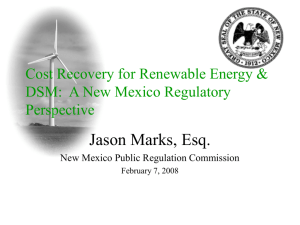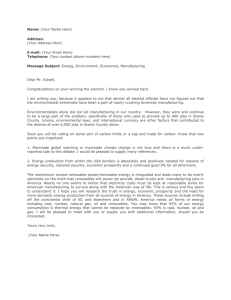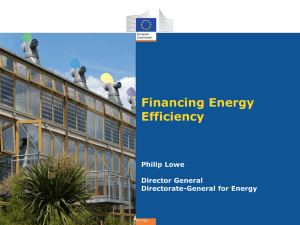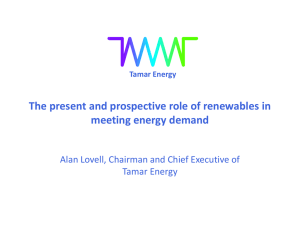Global Market Impacts on Wind and PV
advertisement
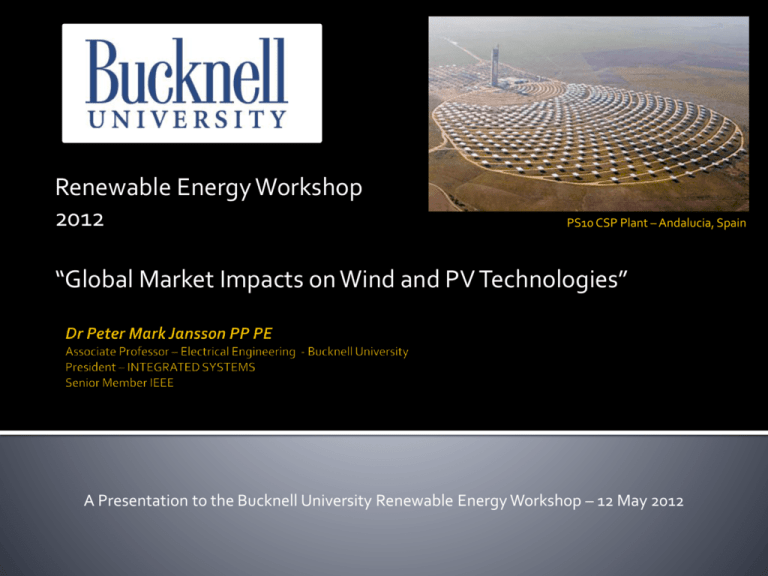
Renewable Energy Workshop 2012 PS10 CSP Plant – Andalucia, Spain “Global Market Impacts on Wind and PV Technologies” A Presentation to the Bucknell University Renewable Energy Workshop – 12 May 2012 Review two renewable energy technologies current market drivers ▪ Technology, economics, electricity demand, environmental concerns, modularity and construction ease, government policy Resulting Market Trends US and Global Impact on Renewable Costs and Electricity Prices Over $3/watt 1) Growing Global Energy/Electrical Demand 2) Technology Experience and R&D 3) Increasing Cost Competitiveness 4) Growing Environmental Concerns 5) Governmental Policy Initiatives ▪ Tax Credits, Feed-in Tariffs, RPS and RECs 6) Rapid/Modular/Ease of Construction 1) Growing Global Energy/Electrical Demand 2) Technology Experience and R&D 3) Increasing Cost Competitiveness 4) Growing Environmental Concerns 5) Governmental Policy Initiatives ▪ Tax Credits, Feed-in Tariffs, RPS and RECs 6) Rapid/Modular/Ease of Construction About 86% Fossil Fuels Biomass, 3 Other, 1.4 Hydro, 2.6 Nuclear, 9.3 CO2 Emissions (millions of metric tons . and per quad) Petroleum: 2598, 64.0 Natural Gas: 1198, 53.0 Coal: 2115, 92.3 Petroleum, 38.9 1 Quad = 293 billion kWh (actual) Natural Gas, 24.1 Coal, 22.6 1 Quad = 98 billion kWh (used, taking into account efficiency) Source: EIA Energy Outlook 2009 (Early Release), Table 1, 2008 Data US EIA - 2009 US EIA - 2007 Source: http://www.eia.gov/cneaf/electricity/epa/figes1.html Nuclear Hydro Fossil Prime Movers (World Electricity 1998,2005,2008 & US 2009) Fossil Fuel (Thermal) powered – 62.8% 66.0% 67.8% 69.1% Nuclear fission – 16.9% 15.2% 13.5% 20.2% Hydro powered – 18.8% 16.7% 15.9% 6.8% Renewables & Other** – 1.5% 2.1% 2.8% 3.9% ** - ‘Other’ includes geothermal, wood, solar and biomass Source: USDOE - EIA and IEA.org Energy in Quads Data says we will be 81% Fossil in 2035!! Source: EIA Annual Energy Outlook, 2010 USA – 99.9 China – 73.8 Russia – 30.4 Japan – 22.8 India – 17.7 Germany – 14.6 Canada – 14.0 France – 11.4 UK – 9.8 Brazil – 9.6 World total is 472; Average per 100 Million people is about 7.32. If world used US average total consumption would be about 2148 quad! Source: US DOE EIA 1) Growing Global Energy/Electrical Demand 2) Technology Experience and R&D 3) Increasing Cost Competitiveness 4) Growing Environmental Concerns 5) Governmental Policy Initiatives ▪ Tax Credits, Feed-in Tariffs, RPS and RECs 6) Rapid/Modular/Ease of Construction SOURCE: S.Kurtz, “Opportunities and Challenges for Development of a Mature Concentrating Photovltaic Power Industry”, NREL Technical Report Feb 2009 Historic Market Growth Technology improvement Near mass production in China SOURCE: U.K.W. Schwabe MSE Thesis 2011 Rowan University 2010 – 143% 2011 – 31.8% 2005-2011 CAGR – 61.5% SOURCE: Schwabe and Jansson 2011> 62 GW <$0.95/ W SOURCE: U.K.W. Schwabe MSE Thesis 2011 Rowan University 1) Growing Global Energy/Electrical Demand 2) Technology Experience and R&D 3) Increasing Cost Competitiveness 4) Growing Environmental Concerns 5) Governmental Policy Initiatives ▪ Tax Credits, Feed-in Tariffs, RPS and RECs 6) Rapid/Modular/Ease of Construction SOURCE: U.K.W. Schwabe MSE Thesis 2011 Rowan University 2012 SOURCES: Prometheus Institute, INTEGRATED SYSTEMS , RAI Services, Inc. 2011 USDoL NY/NJ Average: 20.2 ¢ /kWh ---------------------------- Moving Toward Grid Parity EIA - NJ All Sector Weighted Average: 14.84 ¢ /kWh --------------------------------------------- 2012 EIA – PA Residential Average: 12.6 ¢ /kWh --------------------------------------------- SOURCES: U.K.W. Schwabe, INTEGRATED SYSTEMS Source: http://www.oe.energy.gov/DocumentsandMedia/adequacy_report_01-09-09.pdf Source: National Renewable Energy Lab (NREL), Energy Analysis Office SOURCE: Renewables 2011 – Global Status Report SOURCE: Renewables 2011 – Global Status Report SOURCE: Renewables 2011 – Global Status Report Global Hydro Capacity Continues to increase Large projects less so than small projects Wind Most rapidly expanding in terms of capacity Solar Photovoltaics (PV) Most rapidly expanding in terms of growth rate 100000 38600 35800 27051 24000 19865 MWs of Wind 41000 18200 15197 11531 10000 6500 3440 7270 8133 8207 7500 5950 3760 2826 2520 1290 1000 1283 1530 1466 1744 927 744 730 561.8 MWs of PV 390.5 287.7 201.3 125.8 100 69.4 10 1992 1994 77.6 154.9 88.6 1996 1998 2000 2002 2004 2006 2008 2010 2012 SOURCE: Jansson 2012 World Annual Generation Changes New Year ΔGrowth Wind & PV % 2008 +157 GW 33 GW 21 % 2009 +127 GW 46 GW 36 % 2010 +157 GW 54 GW 34% 2011 +61 GW 65 GW 106% World Wind demand is again expected to be higher than 2011 demand US market growth of 1,695MW (new wind) projects is 52% higher than 2011 Quarter 1* World Photovoltaic demand is also expected to exceed 2011 performance Q1'12 global PV demand is now forecast at 6.9 GW, down 35% Q/Q, but up a huge 146% Y/Y** SOURCES: * - American Wind Energy Association - http://www.awea.org/learnabout/industry_stats/index.cfm * * - Solarbuzz - http://solarbuzz.com/our-research/recent-findings/expectations-policy-adjustmentsgermany-drive-global-pv-demand-146-yy-q Cents per kWh Min 8.4 Max 2012* 14.2 5-13 Wind Costs (2009) PV Costs (2009) * - Does not include 30% Federal Tax Credit, depends on local resource 13.2 29.8 7-18 2009 Data Source: http://www.epa.gov/cleanenergy/documents/renewables_cost_data.xls Wind $1.5 - $2.00 / Watt PV $2 – $3.50 / Watt Coal $3-$3.50 / Watt Gas SOURCE: http://www.ewea.org/index.php?id=1639 $1-$1.50 / Watt Nuclear $4-6.50 / Watt SOURCE: http://www.anga.us/issues--policy/power-generation/clean--efficient The U.S average residential retail price of electricity was 11.53 cents per kWh in 2010 SOURCE: http://www.electricchoice.com/electricity-prices-by-state.php SOURCE: U.S. Dept. of Labor – BLS –News Release 30 Nov 2011 1) Growing Global Energy/Electrical Demand 2) Technology Experience and R&D 3) Increasing Cost Competitiveness 4) Growing Environmental Concerns 5) Governmental Policy Initiatives ▪ Tax Credits, Feed-in Tariffs, RPS and RECs 6) Rapid/Modular/Ease of Construction Climate Change is… US Opinion Under Exaggerated Generally Correct Over Exaggerated No Opinion SOURCE: 2011 Gallup Poll 750 You are Here CO2 / ppmv 500 396 ppm 250 Siegenthaler et al 2005 Vostok + EPICA Dome C 0 600 400 200 Age / 000 years before present 0 Next year over 400 ppm ! Source: http://www.noaanews.noaa.gov/stories2009/images/1208natltemp.png 1) Growing Global Energy/Electrical Demand 2) Technology Experience and R&D 3) Increasing Cost Competitiveness 4) Growing Environmental Concerns 5) Governmental Policy Initiatives ▪ Tax Credits, Feed-in Tariffs, RPS and RECs 6) Rapid/Modular/Ease of Construction Homeowners and Businesses 30% Renewable Energy Investment Tax Credit Businesses and Investors Accelerated Depreciation 30 States with min. standards 7 States with voluntary goals SOURCE: http://205.254.135.7/todayinenergy/detail.cfm?id=4850 WA: 15% by 2020* MT: 15% by 2015 ☼ OR: 25% by 2025 (Xcel: 30% by 2020) MI: 10% + 1,100 MW ND: 10% by 2015 (large utilities)* VT: (1) RE meets any increase in retail sales by 2012; (2) 20% RE & CHP by 2017 MN: 25% by 2025 SD: 10% by 2015 WI: Varies by utility; 10% by 2015 goal ☼ NV: 25% by 2025* ☼ CO: 20% by 2020 IA: 105 MW (IOUs) 10% by 2020 (co-ops & large munis)* CA: 20% by 2010 (Class I Renewables) RI: 16% by 2020 CT: 23% by 2020 ☼ OH: 25% by 2025† ☼ IL: 25% by 2025 ☼ PA: 18% by 2020† VA: 15% by 2025* ☼ NJ: 22.5% by 2021 ☼ MD: 20% by 2022 ☼ MO: 15% by 2021 ☼ AZ: 15% by 2025 ☼ DE: 20% by 2019* ☼ NC: 12.5% by 2021 (IOUs) ☼ DC: 20% by 2020 10% by 2018 (co-ops & munis) ☼ NM: 20% by 2020 (IOUs) ☼ NH: 23.8% by 2025 + 1% annual increase ☼ NY: 24% by 2013 KS: 20% by 2020 UT: 20% by 2025* New RE: 10% by 2017 ☼ MA: 15% by 2020 by 2015* 5% - 10% by 2025 (smaller utilities) ME: 30% by 2000 10% by 2020 (co-ops) TX: 5,880 MW by 2015 HI: 40% by 2030 30 states & DC have an RPS State renewable portfolio standard State renewable portfolio goal Solar water heating eligible ☼ Minimum solar or customer-sited requirement *† 7 states have goals Extra credit for solar or customer-sited renewables Includes separate tier of non-renewable alternative resources Source: http://www.dsireusa.org/ SOURCE: http://srectrade.com/srec_prices.php Time Period Autumn 2009 – December 2010 January 2011 – March 2011 April 2011 May-June 2011 July 2011 August 2011 Sep-December 2011 January 2012 February 2012 March 2012 April 2012 SREC Value $250-$300 / MWhr $176 -$250 / MWhr $ 100 / MWhr $ 80 / MWhr $ 50 / MWhr $ 25 / MWhr $ 10-20 / MWhr $ 20-30 / MWhr $ 10-35 / MWhr $ 10-20 / MWhr $ 20 / MWhr SOURCE: http://srectrade.com/pennsylvania_srec.php 1) Growing Global Energy/Electrical Demand 2) Technology Experience and R&D 3) Increasing Cost Competitiveness 4) Growing Environmental Concerns 5) Governmental Policy Initiatives ▪ Tax Credits, Feed-in Tariffs, RPS and RECs 6) Rapid/Modular/Ease of Construction Designed in 6 months Permitted in 3 months Constructed in 6 months Loss of any one market driver will not change momentum of this industry Most of states in the US (including PA) now have aggressive renewable portfolio standards requiring ever increasing levels of wind, solar and other renewable based electricity. New Jersey’s Experiment was a success – one state can impact global markets and investment in a renewable technology The global demand for wind systems and photovoltaic (PV) systems has been doubling every 1-3 years.
